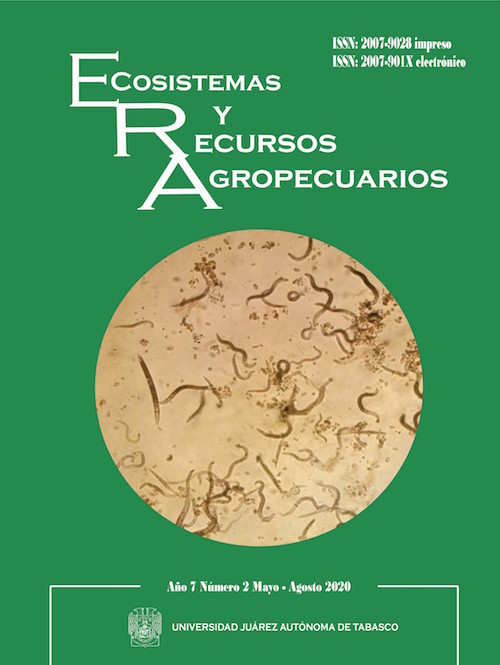Population growth of a generational cohort of the copepod Apocyclops panamensis (Marsh, 1913) under different temperatures and salinities
DOI:
https://doi.org/10.19136/era.a7n2.2505Keywords:
Apocyclops panamensis, Salinity, Temperature, Copepod cultureAbstract
This study was carried out to identify the effects of salinity and temperature during Apocyclops panamensis culture, fed with Tetraselmis chuii. The experiment was conducted in laboratory conditions for 14 days. Nauplii from the same cohort were used to start the experiment, using a density of 1 ind mL−1 in a volume of 400 mL. The feed consisted of a daily supply of 20 000 cell mL−1 of microalgae. Nine treatments with three replicates were evaluated (24◦C-28h, 24◦C-32h, 24◦C-36h, 28◦C-28h, 28◦C-32h, 28◦C-36h, 32◦C-28h, 32◦C- 32h and 32◦C-36h). The factorial ANOVA indicates that temperature had a significant effect on the abundance of total copepods at day 14 (p = 0.02), while salinity did not show a significant effect (p = 0.06) on the total population of A. panamensis. Significant effects of temperature (p < 0.01) and salinity (p < 0.001) were observed for the nauplii population. The best growth of the entire population was reached in the treatment 32◦C-28h, with a population of 1 380.95 (± 1 267.06 ind L−1 (± 1 267.06) at the end of the experiment. Treatments 32◦C-28h and 32◦C-32h produced the highest average population of nauplii and copepodites at the end of the experiment. Adult females presented the greatest abundance in the 32◦C-32h treatment with 214.29 ind L−1, adult males increased between days 11 and 14 in treatments 24◦C-28h, 32◦C-28h, and 32◦C-32h without exceeding 170 ind L−1. In this study, it is evident that A. panamensis prefers warm temperatures and brackish environments.
Downloads
References
Álvarez-Fernández S, Licandro P, Van Damme CJG, Hufnagl M (2015) Effect of zooplankton on fish larval abundance and distribution: a long-term study on North Sea herring (Clupea harengus). ICES Journal of Marine Science 72: 2569-2577.
Anufriieva EV (2015) Do copepods inhabit hypersaline waters worldwide? A short review and discussion. Chinese Journal of Oceanology and Limnology 33: 1354-1361.
Boltovskoy D 1981. Atlas del Atlántico Sudoccidental y métodos de trabajo con el zooplancton marino. Mar del Plata. INIDEP. 936p.
Buttino I, Ianora A, Buono S, Vitiello V, Malzone MG, Rico C, Langellotti AL, Sansone G, Gennari L, Miralto A (2012). Experimental cultivation of the Mediterranean calanoid copepods Temora stylifera and Centropages typicus in a pilot re‐circulating system. Aquaculture Research, 43(2), 247-259.
Cano RRS, Hooker E (2004) The natural diet of Apocyclops panamensis at a shrimp farm on the Pacific coast of Nicaragua. Zoological Studies 43: 344-349.
Castro-Mejía J, Castro-Mejía G, Castañeda-Trinidad H, Ocampo-Cervantes JA, Monroy-Dosta C (2014) Comparación de la densidad poblacional de copépodos del Orden Cyclopoida Burmeister, 1834 alimentados con microalgas más levadura activa seca, en recipientes de 200 L. Revista digital e-Bios 1: 26-33.
Charmantier G (1998) Ontogeny of osmoregulation in crustaceans: a review. Invertebrate Reproduction Development 33: 177-190.
Contreras-Sánchez WM, García MDJC, Vera AM, Vidal UH, Rosado LC (2014) Avances en la inducción al desove y desarrollo embrionario en cautiverio de Centropomus poeyi, Kuxulkab' 20: 6-9.
Conway DVP, McFadzen IRB, Tranter RG (1994) Digestion of copepod eggs by larval turbot Scophthalmus maximus and egg viability following gut passage. Marine Ecology Progress Series 3: 303-309.
Farhadian O, Yusoff FM, Arshad A (2008) Population growth and production of Apocyclops dengizicus (Copepoda: Cyclopoida) fed on different diets. Journal of World Aquaculture Society 39: 384-396.
Flores-Coto C, Espinosa-Fuentes MDLL, Zavala-García F, Sanvicente-Añorve L (2009) Ictioplancton del sur del Golfo de México: Un compendio, Hidrobiológica 19:49-76.
Galindo M 1998. Efecto de la temperatura y la salinidad en parámetros poblacionales de Pseudodiaptomus uryhalinus Johnson (Crustáceo: copépoda calanoidea) en condiciones controladas [Doctoral dissertation]. México: Instituto Politécnico Nacional. Centro Interdisciplinario de Ciencias Marinas 68p.
Gilmore RG, Donohoe CJ, Cooke DW (1983). Observations on the distribution and biology of east-central Florida populations of the common snook, Centrop omus undecimalis (Bloch). Florida Scientist. 46: 313-336.
Gomathi P, Anil MK, Raheem PK, Raju B (2017) Standardization of culture aspects of Apocyclops cmfri sp. nov. a native cyclopoid copepod. Marine Fisheries Information Service, Technical and Extensión Series 231: 17-19.
Hernández-Trujillo S, Esqueda-Escárcega GM (2002) La diversidad de copépodos marinos en México. Oceánides 17: 57-68.
Hernández-Vidal U, Chiappa-Carrara X, Contreras-Sánchez W (2014) Reproductive variability of the common snook, Centropomus undecimalis, in environments of contrasting salinities interconnected by the Grijalva-Usumacinta fluvial system, Ciencias Marinas 40: 173-185.
Hirst AG, Bunker AJ (2003) Growth of marine planktonic copepods: global rates and patterns in relation to chlorophyll a, temperature, and body weight. Limnology Oceanography 48: 1988-2010.
Holste L, Peck MA (2006) The effects of temperature and salinity on egg production and hatching success of Baltic Acartia tonsa (Copepoda: Calanoida): a laboratory investigation. Marine Biology 148: 1061-1070.
Hopkins TL (1982) The vertical distribution of zooplankton in the eastern Gulf of México. Deep Sea Research Part A. Oceanographic Research Papers 29: 1069-1083.
Kahan D, Uhlig G, Schwenzer D, Horowitz L (1982) A simple method for cultivating harpacticoid copepods and offering them to fish larvae. Aquaculture 26: 303-310.
Karlsen Ø, Van Der MT, Rønnestad I, Mangor-Jensen A, Galloway TF, Kjørsvik E, Hamre K (2015) Copepods enhance nutritional status, growth and development in Atlantic cod (Gadus morhua L.) larvae—can we identify the underlying factors?. PeerJ 3: e902.
Koch J, Bui TT, Belleza EL, Brinkmann M, Hollert H, Breitholtz M (2017) Temperature and food quantity effects on the harpacticoid copepod Nitocra spinipes: Combining in vivo bioassays with population modeling. PloS one. 12: 3 e0174384.
Lindley LC, Phelps, RP, Davis DA, Cummins KA (2011) Salinity acclimation and free amino acid enrichment of copepod nauplii for first-feeding of larval marine fish. Aquaculture. 318: 402-406.
Luna FJ, Arce UE, Figueroa TJ (2018) Ventajas e inconvenientes del uso de alimento vivo en la nutrición de peces. Inventio, la génesis de la cultura universitaria en Morelos. 14: 39-43.
Marshall, A. J. 2002). The culture of copepods as live food for marine fish larvae [Doctoral dissertation]. Australia: University of Tasmania. pp 381.
Marchus NH, Wilcox JA (2007) Guide to the meso-scale production of the copepod Acartia tonsa.
Moore EA, Sander F (1983) Physioecology of tropical marine copepods II, Sex ratios. Crustaceana. 44: 113-122.
Næss T, Germain-Henry M, Naas KE (1995) First feeding of Atlantic halibut (Hippoglossus hippoglossus) using different combinations of Artemia and wild zooplankton. Aquaculture 130(2-3), 235-250.
Nichelmann M 1983 Some characteristics of the biological optimum temperature. Journal of Thermal Biology 8: 69-71.
Osorio-Galindo M (1998) Efecto de la temperatura y la salinidad en parámetros poblacionales de Pseudodiaptomus uryhalinus Johnson (Crustáceo: copépoda calanoidea) en condiciones controladas [Doctoral dissertation]. México: Instituto Politécnico Nacional. Centro Interdisciplinario de Ciencias Marinas 68p.
Pan YJ, Souissi A, Souissi S, Hwang JS (2016) Effects of salinity on the reproductive performance of Apocyclops royi (Copepoda, Cyclopoida). Journal of experimental. Marine Biology and Ecology 475: 108-113.
Pais de Lira JG (2002) Influencia da dieta na reproducao e crescimento do copepode, Acyclops procerus, e seu potencial como alimento na larvicultura do robalo-peva, Centropomus parallelus. [dissertação mestrado]. Brasil: em aquicultura, Universidade Federal de Santa Catarina Centro de Ciencias Agrarias 25p.
Payne MF, Rippingale RJ (2000) Evaluation of diets for culture of the calanoid copepod Gladioferens imparipes. Aquaculture 187: 85-96.
Pérez IE, Gómez NS, Puello-Cruz AC (2006) Efecto de diferentes dietas de microalgas sobre la supervivencia y crecimiento de Apocyclops aff. panamensis (Marsh, 1913), (Copépodo: Cyclopoida) cultivado bajo condiciones controladas de laboratorio. Revista Electronica de Veterinarians 7:1-10.
Phelps RP, Sumiarsa S, Lipman EE, Lan HP, Moss KK, Davis AD (2005) Intensive and extensive production techniques to provide copepod nauplii for feeding larval red snapper Lutjanus campechanus. Copepods in aquaculture. pp: 151-168.
Prieto M, Atencio V (2008) Zooplancton en la larvicultura de peces neotropicales. Revista MVZ Cordoba 13:1415-1415.
Prieto M, Castaño F, Sierra J, Logato P, Botero J (2006) Alimento vivo en la larvicultura de peces marinos: copépodos y mesocosmos. Revista MVZ Córdoba 11: 30-36.
Puello CAC, González RB, García-Ortega A (2008) Investigación en Producción y Uso de Copépodos en Larvicultura. pp: 90-107. Editores: E CS, Denis RM, Tapia SM, Nieto LMG, Villarreal CDA, Lazo JP, Viana MT. Avances en Nutrición Acuícola IX. Simposio Internacional de Nutrición Acuícola. México. Universidad Autónoma de Nuevo León.
Rasdi NW, Qin JG (2016) Improvement of copepod nutritional quality as live food for aquaculture: a review. Aquaculture Research 47: 1-20.
Reid JW, Hribar LJ (2006) Records of some Copepoda (Crustacea) from the Florida Keys. Proceedings of the Academy of Natural Sciences of Philadelphia 155: 1-8.
Ribeiro AC, Souza-Santos LP (2011) Mass culture and offspring production of marine harpacticoid copepod Tisbe biminiensis. Aquaculture 321(3-4), 280-288.
Rosas J, Cabrera G, Velásquez A, Cabrera T (2011) Crecimiento poblacional y valor nutricional del copépodo Oithona ovalis, Herbst 1955 (Copepoda: Cyclopoida) alimentado con cuatro especies de microalgas. Ciencia 15(2).
Ruiz-Guzmán JA, Jiménez CA, Gomes C, Prieto MJ (2012) Cultivo experimental de Cyclopina sp. con diferentes especies de microalgas. Revista Colombiana de Ciencias Pecuarias 25: 97-105.
Sánchez-Estudillo L (2011) Alimento nutritivo, colorido y en movimiento: Los cultivos de apoyo en Acuicultura. Ciencia y Mar 43: 55-60.
Schipp G (2006) The use of calanoid copepods in semi-intensive, tropical marine fish larviculture. Avances en nutrición acuícola. Avances en Nutrición Acuícola IX. Simposio Internacional de Nutrición Acuícola. México. Universidad Autónoma de Nuevo León. 84-94.
Støttrup JG (2006) Review on the Status and Progress in Rearing Copepods for Marine Larviculture. Advantages and Disadvantages. Among Calanoid, Harpacticoid and Cyclopoid Copepods in: Editors: Cruz SEL, Ricque DM, Tapia SM, Nieto LMG, David A. Villarreal Cavazos, Puello CAC, García OA. Avances en nutrición acuícola. Avances en Nutrición Acuícola IX. Simposio Internacional de Nutrición Acuícola. México. Universidad Autónoma de Nuevo León 62-83.
Su HM, Cheng SH, Chen TI, Su MS (2005) Culture of copepods and applications to marine finfish larval rearing in Taiwan. Copepods in aquaculture 183-194.
Suárez-Morales E (2000) Copépodos, seres ubicuos y poco conocidos. CONABIO. Biodiversitas 29: 7-11.
Suárez-Morales E (2015) Class maxillopoda. In Thorp and Covich's Freshwater Invertebrates. Academic Press. pp: 709-755.
Suárez-Morales E, Fleeger JW, Montagna PA (2009) Free-living Copepoda (Crustacea) of the Gulf of Mexico. Gulf of Mexico origin, Waters and Biota 1: 841-870.
Suárez‐Morales E, Reid JW, Fiers F, Iliffe TM (2004) Historical biogeography and distribution of the freshwater cyclopine copepods (Copepoda, Cyclopoida, Cyclopinae) of the Yucatan Peninsula, Mexico. Journal Biogeography 31: 1051-1063.
Torrentera BL, Tacon AGJ (1989) La producción de alimento vivo y su importancia en acuicultura. Una diagnosis. Programa Cooperativo gubernamental FAO. Italia. GCP/RLA/075/ITA. Documento técnico. 12: pp 90.
Vanacor-Barroso M, Carvalho CVAD, Antoniassi R, Ronzani-Cerqueira V (2017) The copepod Acartia tonsa as live feed for fat snook (Centropomus parallelus) larvae from notochord flexion to advanced metamorphosis. Latin American Journal of Aquatic Research 45: 159-166.
Velásquez A, Rosas J, Cabrera T, Millán J, Hernández M (2001) Efecto de Tetraselmis chuii, Nannochloris oculata y Dunaliella salina sobre el crecimiento pobla
Downloads
Published
Issue
Section
License
Aviso de copyright
Los autores que se envían a esta revista aceptan los siguientes términos:
una. Los autores conservan los derechos de autor y garantizan a la revista el derecho a ser la primera publicación del trabajo con una licencia de atribución de Creative Commons que permite a otros compartir el trabajo con un reconocimiento de la autoría del trabajo y la publicación inicial en esta revista.
B. Los autores pueden establecer acuerdos complementarios separados para la distribución no exclusiva de la versión del trabajo publicado en la revista (por ejemplo, en un repositorio institucional o publicarlo en un libro), con un reconocimiento de su publicación inicial en esta revista.
C. Se permite y se anima a los autores a difundir su trabajo electrónicamente (por ejemplo, en repositorios institucionales o en su propio sitio web) antes y durante el proceso de envío, ya que puede conducir a intercambios productivos, así como a una cita más temprana y más extensa del trabajo publicado. (Consulte El efecto del acceso abierto).


